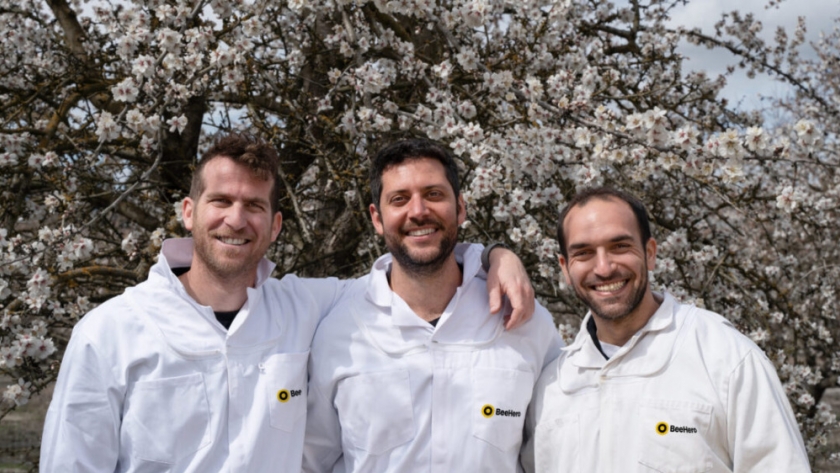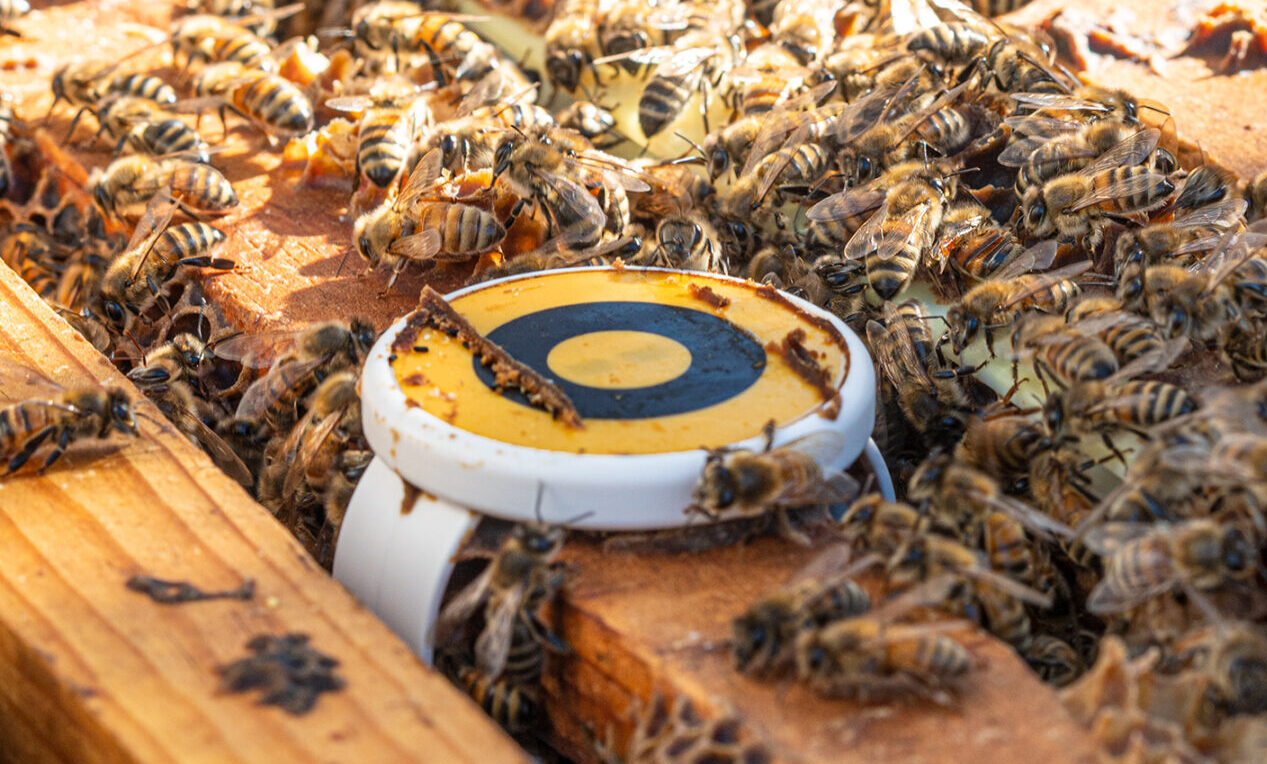
AgFunderNews caught up with Omer Davidi (OD), cofounder and CEO at California-based precision pollination startup BeeHero, at the World Agri-Tech innovation summit in London to discuss:
Pollination pain points for growers and beekeepers.
Sensor technology, which BeeHero now uses to manages 300,000+ hives worldwide.
BeeHero’s progress to date and recent move into the Latam market.
How investors are viewing the pollination tech space.
[B-roll and images in video courtesy of BeeHero.]
OD: “The majority of crops need pollination, so what farmers came up with is basically renting hives. The challenge is that you don’t have any assurance of the quality of hives being deployed in the field, so you end up paying hundreds of dollars per acre, and during the pollination time frame, you might realize that 20% of those boxes are actually empty.
“For growers, it [renting hives] now costs hundreds of dollars per acre; people are paying more and more for pollination but they don’t know what they’re actually getting because there’s a lack of transparency. And that’s where I think the frustration comes from. At BeeHero, we’ve built a model helping beekeepers introduce more efficient hives.”
OD: “We utilize small sensors that go into the beehive, so we can track and monitor what happens inside those boxes, 24/7, all year long. And then we offer farmers precision pollination as a service, basically ensuring that the quality of those hives being deployed in the field will meet the requirement to get the full pollination that they need.
“We have nine different sensors inside our small units that go inside the hives. The main three inputs are sound, temperature, and humidity. A beehive is a super organism. If the Queen is failing, the bees will act in a different way, and over the last few years, we’ve collected tons of data and identified signatures of all these different activities. So we can identify if the queen is failing, if the hive going through a starvation situation, are there mite problems and so on.
“In terms of temperature, for example, the hive needs to maintain a certain temperature to incubate the eggs that the queen lays and to support the bees’ development. If you’re exceeding certain temperature thresholds for a certain amount of time, the development of the bees will not be as expected, and very soon you get bees that are not as effective and the colony will start to collapse.
“The sounds in a hive can tell you a lot about what is happening, so for example, you can tell when the bees are foraging. When you aggregate this data with environmental parameters and so on, you know whether you’re getting good or bad pollination. At night where there’s no foraging activity, they hydrate the nectar to produce the honey, and at that point, the level of energy that they spend on hydrating the nectar [in the hive] helps you to get a good understanding of how much nectar they collected.
“We don’t need to tell beekeepers what to do to address these issues; they know better than us. But they need to know there is a problem.”

OD: There are things you can do [with the information relayed by the sensors] in real time, but most of the effort is behind the scenes, all year long. By providing beekeepers with insights into what’s happening in those hives, supporting their ability to treat their hives better, to maintain stronger and healthier hives, we can ensure that the quality of hives being deployed in the field is much higher.”
OD: “BeeHero uses in-field monitoring to get a better sense of pollinators’ activity in the field. The question is, what are the bees doing? For example, if you are deploying certain products into the field that affect pollination activity, you might be getting the best bees, but still no pollination.
“So one of the things we identified as we started to deploy sensors into the field were situations where male and female [plants], for example, are not aligned, or you have different varieties [of a crop] in the field that are not blooming at the same time. [One of the biggest challenges for fruit and nut growers is insufficient winter chill—warmer winters, which have been attributed to climate change—which means male and female trees do not always flower at the same time. This results in sub-optimal pollination and a resulting reduction in yields.]
“And some things can then be adjusted [accordingly]. So you can play with irrigation in order to sync certain genders or varieties to bloom together, which improves the quality of pollination. And that became kind of a bundle opportunity for farmers to get an end-to-end solution for their entire pollination needs.
“It’s not just about introducing the strongest pollinators out there; it’s also ensuring that the practice of pollination is done well, so a key part of our efforts is to introduce more of a long-term pollination solution to support the industry for many more years down the road.”
OD: “We’ve established a model that basically meets the same ballpark of pricing that farmers pay today, but with the quality of pollinators that they need. I can show you tons of case studies that show why good pollination improve yields, but we are very cautious in our claims, so we [don’t provide hard numbers about] improving yields. We are improving hives.
“It’s really about input versus output. Pollination is correlated to yield, but if you’re deploying five times the number of hives that you need [for successful pollination], we cannot help you to improve outputs, you’re already over-deploying bees. We’ve seen farms where we can actually recommend that farmers user fewer hives, whereas before, they wouldn’t want to take the risk. But now there’s no risk because we know what’s happening.”
OD: “We’re the largest pollination provider in the US market [generating] tens of millions of dollars in revenues… and we’ve expanded [beyond the initial market of almonds] through crops such as apples, cherries, and berries. Last year we expanded to the Australian market, starting with almonds, but also canola, avocados, macadamias, and just recently, we announced* our expansion into Latin America, starting with Peru, Chile, and soon Mexico.
“There’s a lot of expansion in the berry market in Latin America, and also in avocados, which is a high value crop that is extremely dependent on pollinators. We are getting closer to $100 million in revenues. We expect to be there very soon. This year, we’ll probably exceed $70 million.”
OD: “We’re seeing a lot more investments in the pollination space. When we first started, seven years ago, we had to explain why pollination is important. The fact that we see more money deployed into this field only highlights the fact that people are starting to realize the risk exposure associated with not getting good pollination, and the fact that pollination will not look the same five years down the road. So that’s definitely a positive thing.
“We’ve raised around $62 million to date. We will probably do another fundraise, mainly to support our geographic expansion, but as we focus on very low cost components, we’re on the profitability path, so it’s [fundraising] less about being dependent on external money, but more about maturing the company, bringing the experience we need, and preparing for the future.”
*BeeHero has just signed a Memorandum of Understanding (MOU) with CONAPI, the National Confederation of Beekeepers of Peru, with the two committing to conduct collaborative development projects and joint market education initiatives about the importance of beekeeping for commercial pollination.
AgFunderNews
